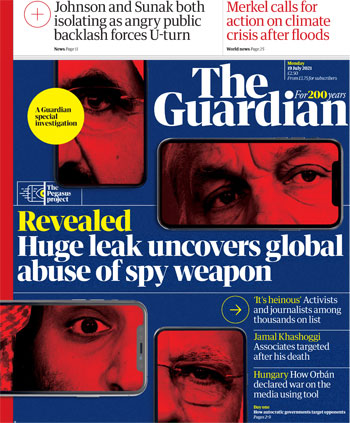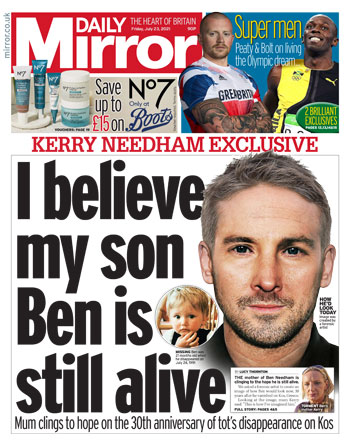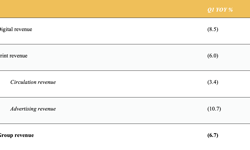
France’s job?
You may have been too busy celebrating Freedom Day and the gold rush of Olympic medals to notice, but Britain is in the middle of a “migrant crisis”.
This is exercising both our home secretary and the newspapers that generally support her. Indeed, the latter have not paid so much attention to people desperate to come here since the heady summer days of 2016 when there was a Brexit referendum to be won.

Last week saw three key events: the second reading of Priti Patel’s Nationality and Borders Bill, a new daily record for the number of boat people arriving on Kent beaches, and a £54m sweetener to persuade the French to do more to deter people from setting off from their side of the Channel. Various permutations of these elements provided page one material for the Times, Telegraph, Mail, Metro and Express – whose front has generally been shorn of immigration stories since Gary Jones took the chair in 2018, saying that the paper’s previous hostile headlines had given him sleepless nights.
To be fair, this time the outrage was not so much at the refugees / asylum-seekers / migrants / illegals (depending on your outlook) as at the idea of spending our money to pay the French “to do their job”. Though why it is France’s job to stop anyone – other than a fugitive criminal – wanting to leave the country for somewhere else is not clear to me.
A numbers game
The Mail and Telegraph also focused on the cash, the Times on the numbers, and Metro on “fury” at a French warship escorting a dinghy out into international waters – which has to be the ultimate example of washing your hands of a problem you want someone else to deal with.
The Times returned to the issue on Saturday, with a splash headline that declared “Latest wave of Channel migrants to hit 22,000”. This was not, as the wording suggests, a fact, but a prediction. It may have been based on sound data, but it was still only a projection, someone’s estimate. There was plenty of scope in that headline count to make that clear – even if only a couple of quote marks. But, no. The paper went for the intimation of unavoidable horror.
Would 22,000 be a lot? Well, it’s a lot of scared, desperate people. But that wasn’t the message the Times was trying to put across. It was their impact on us that was the paper’s – and Patel’s – concern. The home secretary was so furious that she had “hauled in” the “clandestine threat commander” and read him the riot act. The clandestine threat commander? If boatloads of destitute people should be his biggest worry, the country must be in security heaven.
Most papers reported that the total number of crossings last year – a record – had “already” been surpassed. So, it is a rising problem. But there is also bit of alarmism in that construction because while we may be only just over halfway through the calendar year, we are more than 80% of the way through the reckless-Channel-crossing season. People were emboldened last week by the fine, calm weather and that – as we have seen from the storms this week – can change.
There is no doubt that traffickers are profiting from people willing to risk everything to start a new life in a new country and governments need to do all they can to stop them. But too often, the debate is framed not with compassion but hostility; we are asked to consider not the plight of those on the boats, but the inconvenience to ourselves. Patel has declined to visit Napier barracks on Folkestone, where asylum-seekers have been detained in Covid-rampant dormitories, like Russell T. Davies’s Years and Years drama brought to life. But she could not dodge MPs, either in the Commons or in select committee. “People have simply had enough of illegal migration and the abuse of our asylum system,” she declared, as she outlined plans to “process” asylum-seekers anywhere but here and to jail people who arrived “without permission”.
The Mail titles seem to agree – the daily has devoted 23 pages to the boat people in the past two weeks, while its Sunday sister also seems to have had enough of the home secretary, branding her the “minister for hot air” and listing a catalogue of her promises that have so far come to nothing.
Too often, the debate is framed not with compassion but hostility.
A burning issue? For whom?
But have people had enough? Do voters care that much about this “invasion” of our shores? The latest Ipsos-Mori “key issues” poll found, unsurprisingly, that Covid was the biggest concern, mentioned by 56% of people questioned. The economy came next with 27%, followed by the NHS on 24% and Brexit and education on 23%. The environment and poverty were also more on people’s minds than immigration, which was mentioned by only 13% of voters questioned. Not such a big issue then.
And while these papers fret over 22,000 illicit incomers (incidentally, the number applying for asylum remains pretty static for years at around 30,000 per annum), they have little time to pay attention to the estimated 1.4m who have left the country over Brexit or the pandemic in the past year. Farmers can’t get their crops harvested; the NHS is desperately short of nurses; pubs, hotels and restaurants can’t find staff; there are 100,000 vacancies for lorry drivers. But those empty supermarket shelves are all down to the “pingdemic”. They have absolutely nothing to do with our attitude to foreigners.
Contrasting views on the home secretary

It’s been quite the roller-coaster fortnight for Priti Patel, quite apart from the attacks on all sides about her approach to asylum-seekers. There was the spat with Tyrone Mings over football racism and taking the knee, the Police Federation passing a vote of no confidence in her over their members’ pay freeze, a torrid session in front of the Home Affairs select committee, and finally her plans to tackle louts, burglars and knife-carriers.
In this last, the prime minister stole her thunder, having had his second anniversary party balloon popped by the need for a spell of self-isolation last week. While the home secretary spoke of “louts” sentenced to community service “publicly and visibly” making reparation for their crimes, Boris Johnson spelt out the plans more graphically with “bring on the chain gangs in hi-viz jackets”.
From a Press-watcher’s perspective, though, the intriguing thing here has been to see the Mail titles in action. The rivalry between Paul Dacre and Geordie Greig was well documented, but is there still a frisson now that Greig has moved to the daily and Ted Verity is occupying his old chair at the Sunday?
For, while this week’s MoS monstered the “Minister for hot air”, Tuesday’s Mail gave her a splash and a column to set out her wares, under the headline “Priti: I’ll make yobs clean the streets”.
From a Press-watcher’s perspective, though, the intriguing thing here has been to see the Mail titles in action.
Jailing journalists?

There was one subject, however, on which all papers agreed that the home secretary was firmly in the wrong. Hard on the heels of the raids aimed at finding out who sent that video of Matt Hancock and Gina Colandangelo to the Sun (rather than concentrate on what state business was being conducted on his private email account), she now intends to change the Official Secrets Act to staunch future leaks.
Her proposals would remove any public interest defence for “unauthorised disclosure” of information and threaten journalists with up to fourteen years in jail merely for holding secret information, whether they publish it or not.
Priti Patel, whose abiding concern for our free press led her to put pressure on police to stop an Extinction Rebellion protest at printing plants, does not apparently see any disconnect here.
Nor does she think that her measures would deter whistle-blowers seeking to expose wrongdoing – they can go to their bosses, she says. Right. That always works.
Her proposals would remove any public interest defence for “unauthorised disclosure” of information.
Pegasus, anyone?

The Times’s Saturday leader questioning Patel’s proposed reform opened with a reminder to the Government of the “global press freedom” campaign it launched after the murder of Jamal Khashoggi three years ago. It pointed out how journalism can be a force for good and how the British attitude compared favourably with “authoritarian rivals” and the repressive approach seen in Hong Kong.
How timely that the paper should bring up Khashoggi. For the previous Monday, the Guardian had gone gangbusters on a new raft of papers, courtesy of Amnesty International, allegedly showing that authoritarian regimes were misusing spyware to monitor the activities of journalists, human rights activists, lawyers and politicians – including, apparently, Khashoggi and his associates, both before and after his death.
The Pegasus spyware is produced by the Israeli NSO group, which at the time vehemently denied that its hacking equipment had been used against Khashoggi. It maintains that its clients are sold the equipment – which can infect phones so that the hacker can monitor calls, messages, emails and photos and even use the microphone – solely for use against criminals and terrorists.
Over three days and 22 pages, the Guardian detailed how it believed Pegasus had been used by Saudi Arabia, Hungary, India and Mexico among others. The data leaked included 50,000 phone numbers, with those of France’s Emanuel Macron, Pakistan’s Imran Khan and South Africa’s Cyril Ramaphosa among them. Besides the Khashoggi murder, Pegasus was reportedly implicated in the killing of Mexican journalist Cecilio Pineda Birto and in the surveillance of a number of reporters in Victor Orban’s “war on the media” in Hungary. There were 180 journalists on the list of numbers belonging to potential “persons of interest”, including the editor of the FT.
There were 180 journalists on the list of numbers belonging to potential “persons of interest”, including the editor of the FT.
What did other papers make of it? Err…
It was a very big exclusive, published in collaboration with fifteen other news organisations from around the world, and you might expect other British newspapers, with their much-trumpeted defence of press freedom, to pick up on it. And so they did. The Mail made it a page 17 lead, the Times put it on the bottom of page 4, the i ran a double column on 13, the Telegraph found a slot at the foot of page 11, and the Sun gave it 71 words on page 2.
By the next day, it was generating a little more interest: the Mail’s Guy Adams produced a 1,700-word spread, the Times promoted the subject to a page lead, the Telegraph moved it from the bottom to the top of a world news page. Well, they’d had more time to digest its importance. Or was it the new angle they had found that piqued their interest? While the Guardian was splashing on “Attack on democracy: furious reaction to spying revelations”, the Times head was “Cherie Blair law firm linked to spy group” and the Telegraph’s “Cherie Blair under scrutiny for firm’s link to spyware developer”.
Adams in the Mail focused on the surveillance of Khashoggi’s wife and the way the technology could be used to target anyone in possession of a phone. But, while he left the killer fact to the last three pars, the standfirst writer understood what really mattered: “It starts with an innocent message. It could end with your intimate secrets stolen by some of the world’s most sinister regimes. And guess who’s on the payroll of the tech firm behind it? Cherie Blair”.
Of course. For who in their right mind would worry about democracy or press freedom when they can take a pop at Cherie?
For who in their right mind would worry about democracy or press freedom when they can take a pop at Cherie?
Dragging up the past

The arts and media are addicted to anniversaries. They provide a fount of inspiration for museum curators, authors, broadcasters and features editors with forests of empty newsprint to fill. And to make their lives even easier, there are countless internet lists of landmarks: it’s 200 years since the Irish potato famine and since John Constable painted the Hay Wain. The Albert Hall was opened 150 years ago; the Royal British Legion formed a century ago. Starbucks and decimal currency made their first appearances – and free school milk disappeared – 50 years ago; Princes Charles and Andrew were divorced a quarter of a century ago, in a year that also saw the Dunblane massacre and the birth of Dolly the cloned sheep.
Amy Winehouse died ten years ago last week – hence the rush of books, documentaries and magazine reminiscences – and over the same weekend, Anders Brevik killed 77 people in Norway. I doubt we’ll get through today without at least a dozen reminders that this would have been Charles and Di’s ruby wedding anniversary – had they stayed married and she had stayed alive. It’s no coincidence that we’ve been seeing a lot of Elizabeth Emanuel of late. As I say, the (sometimes crumpled) material is endless if you know where to look.
Some of the resultant features drag up painful memories for little apparent reason, other than to sell merchandise – be it in the form of tickets, books or newspapers. And so it was that I was troubled by last Thursday’s Daily Mirror with its front page “I believe my son is alive” alongside a picture of a thirtysomething man.
I guessed immediately that this was supposed to be Ben Needham, whose disappearance as a toddler from a holiday home in Kos in 1991 created a media frenzy of a kind surpassed only by that generated by Madeleine McCann sixteen years later.
In the Mirror piece, Ben’s mother Kerry says that she has not given up hope that her son is alive. Of course, she hasn’t. Any more than the McCanns have. Until they have remains to prove beyond doubt that their children are lost to them, these parents will cling to the tiny chance that one day they might come home.
Some of the resultant features drag up painful memories for little apparent reason.
Too much to bear
Five years ago, a contractor who had been clearing a development site on Kos told Yorkshire police that the boy had been crushed by one of his digger drivers – who had since died – and that the accident had been covered up. It seemed to be the solution to the mystery, albeit conveniently around the 25th anniversary of Ben’s disappearance, and it was all reported by the Mirror as “Ben Needham sensation” and “Too much to bear” at the time.
Now, the paper – which has an obsession with old crimes and police cases – has chosen another landmark anniversary to disbelieve that account and ask an artist to come up with an impression of what Ben might look like now. This enterprise was undertaken, it says, with the consent of Ms Needham and the police. Ms Needham further endorses the effort by saying that the picture produced is exactly how she sees her son in her head.
Meanwhile in Germany, police believe that Madeleine was killed soon after her disappearance from the Algarve and that they have the killer in custody. Last week, the Mirror (and other papers) reported that the UK has earmarked a further £350,000 – on top of £12.5m it has already spent – to try to find out what happened to her. Now a new Channel 5 documentary series is looking at suggestions that two Russians, rather than prime suspect Christian Brueckner, were behind the abduction. This “development” has, of course, caught the attention of the Mirror, although only in its online incarnation.
It is human nature to want to know what happened to these children. We all like mysteries solved, happy endings. A happy ending in either of these cases would be the most sensational story imaginable – and that very fact shows how impossibly unlikely it is. But these “never give up” stories serve no purpose other than to trade on bereaved parents’ misery. Until there is real news, it’s the press pack that should give up – and leave the families to reflect on their lost loved ones in peace.
These “never give up” stories serve no purpose other than to trade on bereaved parents’ misery.
Olympic joy

The run-up to an Olympic Games is always full of stories of building projects running behind schedule and over budget, but – Rio’s green diving pools aside – it generally all turns out all right in the end. The 2020 Games were even more benighted, thanks to Covid, and right up to the opening ceremony last weekend, the subject of unprecedented protests among the people supposed to be hosting the world.
But even without a single spectator, the delayed Games seem to be going well. We here in Britain are delighting in our early clutch of medals and in the sight of the Union Flag being waved and worn with joy rather than jingoism. Naturally, especially after the footballers’ almost-triumph at the Euros, our papers are right behind Team GB and they have been spoilt for choice when it comes to a main picture.
It was interesting, then, to see the FT, Guardian and Times go for the bigger news story rather than the “patriotic” one yesterday and put Simone Biles on their fronts. The Telegraph went for Charlotte Dujardin, whose team dressage bronze put her career medal haul on a par with British record-holders Katherine Grainger and Kathleen Godfree, anticipating that she would overtake them later in the day, which by winning another bronze, Dujardin subsequently did. The Express used a composite of swimmer Tom Dean and the women’s gymnastics team, while the Mail homed in on twins from that gymnastic team.
But for me, the runaway winner of the “most joyous picture of the Games so far” award is the Daily Telegraph with its photograph of Tom Daley hugging diving partner Matty Lee. An absolute stunner.
Our papers are right behind Team GB and they have been spoilt for choice when it comes to a main picture.
Liz Gerard’s Notebook is a fortnightly column published in the InPubWeekly newsletter. To be added to the mailing list, enter your email address here.










